Distribution and Exchange
When goods and services are given away,
purchased, sold, or traded, there are potentially
two components of the exchange--pure economic gain and social gain.
Both of these motives usually occur at the same time in
non-market economies. However, in market economies, the social component is often
missing except when the exchange is between relatives or friends.
With strangers, the social gain is usually sacrificed for efficiency and speed.
Important exchange items in non-market economies include many more things than just food and manufactured objects. The most valued gifts are likely to be courtesies, entertainment (e.g., songs, dances, and speeches), curing, military assistance, women (to be wives), and children. In the Western World today, the idea that women and children could be given away as gifts is shocking. However, that was not always the case in Europe. Well into the 19th century, the heads of royal and wealthy families gave their daughters and sometimes sisters in marriage in order to establish or solidify economic and political alliances. Men giving female relatives to potential male allies has been a powerful bonding tool throughout most of the world.
Gift exchanges are
usually reciprocal
![]() .
That is to say, if you receive a gift, you are obliged to repay it with
another gift. Reciprocity
.
That is to say, if you receive a gift, you are obliged to repay it with
another gift. Reciprocity
![]() typically results in a continuing sequence of giving, receiving, and repaying
gifts. Breaking this obligation to continue the
reciprocity is commonly seen as a slight or even a rejection of the other
person involved in the exchange. Reciprocity is a binding
mechanism in that its continuance helps to hold friends and families together.
Reciprocal exchanges generally do not redistribute a society's wealth in a way
that causes some people to become richer than others. Rather, they
usually result in a circulation of goods and services. There is not a
net economic loss for individuals because they ultimately receive gifts in
return.
typically results in a continuing sequence of giving, receiving, and repaying
gifts. Breaking this obligation to continue the
reciprocity is commonly seen as a slight or even a rejection of the other
person involved in the exchange. Reciprocity is a binding
mechanism in that its continuance helps to hold friends and families together.
Reciprocal exchanges generally do not redistribute a society's wealth in a way
that causes some people to become richer than others. Rather, they
usually result in a circulation of goods and services. There is not a
net economic loss for individuals because they ultimately receive gifts in
return.
Reciprocity requires adequacy of response but not necessarily mathematical equality. In North America, for instance, when adults give a Christmas gift that cost $50 to a five year old child, they do not expect that the child will reciprocate with a gift that also cost $50. If the child reciprocates with a small painting he or she made in school, it is usually considered to be a more than adequate response.
Types of Reciprocity
 |
|
|
Example of generalized reciprocity |
|
Reciprocal exchanges are not all alike. In 1965, an anthropologist named Marshall Sahlins observed that there are three distinct types of reciprocity that occur in human societies around the world--generalized, balanced, and negative. Generalized reciprocity is gift giving without the expectation of an immediate return. For example, if you are shopping with a friend and you buy him a cup of coffee, you may expect him to buy you one in return at some time in the future. However, you would likely be mildly offended if he insisted on buying you a cup of coffee at the same time that you bought him one. To do so would suggest that he does not wish to become involved in a continuing reciprocal exchange with you. In a sense, it is a rejection of your token of friendship.
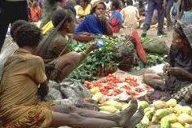 |
|
|
Example of balanced reciprocity |
|
With balanced reciprocity, there is an explicit expectation of immediate return. Simple barter or supermarket purchases involve this understanding. If you walk out of a store without paying for the goods that you have taken, you very likely will be stopped by the store employees and possibly arrested because you failed to immediately reciprocate with the appropriate amount of money. Christmas gifts in the Western World are also usually a form of roughly balanced reciprocity. If you go to the home of relatives or close friends on Christmas and give them Christmas gifts, there is an expectation that you will receive gifts in return at the same time. If you do not receive them, you are likely to infer that your relatives or friends either made a social mistake or do not care about you. On the other hand, giving a birthday present is more like generalized reciprocity because you do not expect a gift in return when you give one. However, you may expect to get one from the recipient of your gift later in the year when your birthday comes along.
 |
|
|
Example
of negative reciprocity |
|
Negative reciprocity occurs when there is an attempt to get someone to exchange something he or she may not want to give up or when there is an attempt to get a more valued thing than you give in return. This may involve trickery, coercion, or hard bargaining. For instance, your neighbor may be offered a new job in a distant city starting in two days. She desperately needs to sell her car before she leaves. It is nearly new and it cost her $22,000. You offer her $10,000 which she reluctantly accepts because there is no other choice. Your taking advantage of her situation resulted in negative reciprocity.
 |
|
|
Example of
negative reciprocity |
At times, negative reciprocity does not involve taking advantage of someone. In fact, someone may willingly give you more than you believe that you are giving in return. For example, a poor student wanting to go to an expensive university might be polite and respectful toward a rich uncle with the hope that he will help out financially. That uncle may gladly pay for his nephew's or niece's education in return because of the attention and recognition that he receives. The money is relatively unimportant to him compared to the respect and attention that is offered. Likewise, an employee acting respectful, or even subservient, towards an employer in order to get a promotion could be considered an attempt at gaining a negative reciprocity advantage in the workplace.
Redistributive Exchanges
Some economic exchanges are intended to distribute
a society's wealth in a different way than exists at present.
These are referred to as redistributive exchanges
![]() . They usually function as
economic leveling mechanisms. In the Western World, charity and
progressive income tax systems are examples of redistributive exchanges.
Progressive income taxes are intended to make people with greater wealth give
at higher rates than those at the bottom of the economic ladder. Some of
the tax money is then allocated to help the poorer members of society.
The intended net effect is to reduce or prevent extremes of wealth and
poverty. When wealthier individuals in a society make charitable donations,
it can have a similar effect. What the donors get in return may be a tax
advantage, a relieved social conscience, and/or increased social status and
recognition. Indeed, one of the main reasons that some very wealthy
individuals make sure that their large charity donations are publicized is
because of the public recognition that results.
. They usually function as
economic leveling mechanisms. In the Western World, charity and
progressive income tax systems are examples of redistributive exchanges.
Progressive income taxes are intended to make people with greater wealth give
at higher rates than those at the bottom of the economic ladder. Some of
the tax money is then allocated to help the poorer members of society.
The intended net effect is to reduce or prevent extremes of wealth and
poverty. When wealthier individuals in a society make charitable donations,
it can have a similar effect. What the donors get in return may be a tax
advantage, a relieved social conscience, and/or increased social status and
recognition. Indeed, one of the main reasons that some very wealthy
individuals make sure that their large charity donations are publicized is
because of the public recognition that results.
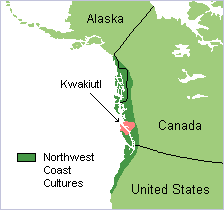 |
|
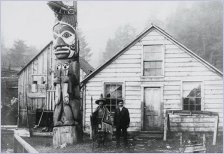 |
|
Redistributive exchanges are not unique to the
Western World. In fact, some of the most elaborate ones that we know of
have been in small-scale societies with non-market economies. The
potlatch
![]() among the Indian cultures of the Northwest Coast region of North America is a good
example. This was a complex system of competitive feasting,
speechmaking, and gift giving intended in part to enhance the status of the
giver. While potlatches were important traditions of
Indian communities from Oregon to Southern Alaska, they are most well known
among the Kwakiutl
among the Indian cultures of the Northwest Coast region of North America is a good
example. This was a complex system of competitive feasting,
speechmaking, and gift giving intended in part to enhance the status of the
giver. While potlatches were important traditions of
Indian communities from Oregon to Southern Alaska, they are most well known
among the Kwakiutl
![]() people of northern Vancouver Island and Queen Charlotte Strait in Western Canada. For the Kwakiutl,
potlatches were important social gatherings held to celebrate major life
events such as a
son's marriage, the birth of a child, a daughter's first menses, and the
initiation of a sister's son into a secret society. They also were used
to assert or transfer ownership of economic and ceremonial privileges.
It sometimes took years to accumulate the things needed for a big potlatch.
Loans (with interest) had to be called in from relatives for this purpose.
When all was ready, high ranking, influential people from the local and other communities were
invited for several days of feasting and entertaining. Guests were
seated according to their relative status. The host made
speeches and dramatically gave gifts of food, Hudson Bay Company blankets,
canoes, slaves, rare native copper artifacts, and other valuable items to the guests.
The guests with higher status received more. The host sometimes also destroyed money, wasted fish oil by throwing it on
a
fire, and did other things to show that he was willing to economically bankrupt
himself in order to increase his social status. The acceptance of the gifts was an affirmation
of the host's generosity and subsequently of his increased status. The
feast and the gifts essentially placed the guests in debt to their host until
they could at some future time invite him to their own potlatch and give him more than
he gave them--in essence a return on an investment. The potlatch served
as a tool for one-upmanship for important Kwakiutl men.
people of northern Vancouver Island and Queen Charlotte Strait in Western Canada. For the Kwakiutl,
potlatches were important social gatherings held to celebrate major life
events such as a
son's marriage, the birth of a child, a daughter's first menses, and the
initiation of a sister's son into a secret society. They also were used
to assert or transfer ownership of economic and ceremonial privileges.
It sometimes took years to accumulate the things needed for a big potlatch.
Loans (with interest) had to be called in from relatives for this purpose.
When all was ready, high ranking, influential people from the local and other communities were
invited for several days of feasting and entertaining. Guests were
seated according to their relative status. The host made
speeches and dramatically gave gifts of food, Hudson Bay Company blankets,
canoes, slaves, rare native copper artifacts, and other valuable items to the guests.
The guests with higher status received more. The host sometimes also destroyed money, wasted fish oil by throwing it on
a
fire, and did other things to show that he was willing to economically bankrupt
himself in order to increase his social status. The acceptance of the gifts was an affirmation
of the host's generosity and subsequently of his increased status. The
feast and the gifts essentially placed the guests in debt to their host until
they could at some future time invite him to their own potlatch and give him more than
he gave them--in essence a return on an investment. The potlatch served
as a tool for one-upmanship for important Kwakiutl men.
During the 19th century, there was a continuous cycle of potlatches among the Kwakiutl in which the amount of wealth given away progressively escalated. The Canadian government outlawed potlatches in 1884 partly out of the mistaken belief that the Kwakiutl were bankrupting themselves. In fact, very little wealth was being lost. What was happening was a redistribution of perishable goods and items of high value throughout the society. Men who voluntarily gave away their wealth in potlatches were later the recipients of many potlatch gifts. The Canadian government finally lifted their ban on potlatches in 1951. Potlatches are again occurring openly among the Kwakiutl and some other indigenous peoples of the Northwest Coast. Today, they are used to commemorate important family and clan events such as baby showers, weddings, school graduations, special anniversaries, and in memory of dead relatives.
NOTE: While the 19th century
Kwakiutl potlatch feasts were greatly focused on impressing other men of high
status in order to move up in social ranking, this competitive aspect of gift
giving was less important for other Northwest Coast societies. Among the Salish
![]() people of Washington and Oregon, this sort of competition was
considered to be inappropriate. Among the Tlingit
people of Washington and Oregon, this sort of competition was
considered to be inappropriate. Among the Tlingit
![]() of southern Alaska,
gifts given at mortuary potlatches were simply intended as compensation for
assisting at the funeral.
of southern Alaska,
gifts given at mortuary potlatches were simply intended as compensation for
assisting at the funeral.
Among many of the indigenous societies of New
Guinea, elaborate redistributive exchanges similar to the potlatch have been
very important cultural traditions. In order to increase personal status
and become a respected "big man," senior men often spent years accumulating
pigs and other valuable, exotic items such as cassowaries
![]() (large birds similar to emus and ostriches) in order to give them away at
elaborate ritual feasts. As in the case of the potlatch, recipients of
pigs and other valuable things were obliged to return gifts of greater value
at some time in the future. Failure to do so would be unthinkable
because of the loss of respect and status that would result. Perhaps the
most well known of the New Guinea pig give-away traditions was among the Kawelka
of the Central Highlands. As a result of trade with the outside world,
the Kawelka pig give-away events had grown in scale by the 1970's to include
motorbikes, trucks, and tens of thousands of Australian dollars. At
times, the
total value of the goods given away reached hundreds of thousands of dollars. This
was an extraordinarily large fortune for essentially subsistence base horticultural societies. It is important to
keep in mind that most of this wealth actually circulated within the
society. As a result, there was very little net loss. However, a
small number of the pigs were eaten and the cassowaries were usually killed
for their feathers.
(large birds similar to emus and ostriches) in order to give them away at
elaborate ritual feasts. As in the case of the potlatch, recipients of
pigs and other valuable things were obliged to return gifts of greater value
at some time in the future. Failure to do so would be unthinkable
because of the loss of respect and status that would result. Perhaps the
most well known of the New Guinea pig give-away traditions was among the Kawelka
of the Central Highlands. As a result of trade with the outside world,
the Kawelka pig give-away events had grown in scale by the 1970's to include
motorbikes, trucks, and tens of thousands of Australian dollars. At
times, the
total value of the goods given away reached hundreds of thousands of dollars. This
was an extraordinarily large fortune for essentially subsistence base horticultural societies. It is important to
keep in mind that most of this wealth actually circulated within the
society. As a result, there was very little net loss. However, a
small number of the pigs were eaten and the cassowaries were usually killed
for their feathers.
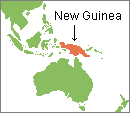 |
 |
Papua New |
Commerce Between Small-scale Societies
So far, we have primarily examined the nature of economic exchanges within a single society. As the scale of societies gets larger, they increasingly become involved in commercial exchanges with other societies.
During the last two centuries, international commerce resulted in an enormous redistribution of wealth to the industrialized nations located mostly in the northern hemisphere. This process essentially began with Western European nations draining the surpluses from their colonies in Asia, Africa, and the Americas. The colonies provided raw materials at low prices for European factories, and the colonists bought the products of those factories at elevated prices. The net effect of this institutionalized negative reciprocity has been that the majority of the former European colonies are still underdeveloped poor nations.
As the old colonial empires collapsed over the last half century, multinational corporations and large banks continued the process of draining the surpluses from underdeveloped regions and funneling them mainly into Western Europe, North America, Korea, Japan, Taiwan, Hong Kong, Singapore, and a few oil rich nations (especially around the Persian Gulf). China and India are in the process of joining this club of major international creditors. It is not likely that this progressive redistribution of global wealth to a few rich nations can go on forever without serious consequences for the global economy. Trade imbalances can cripple economies in debtor nations when their debts become larger than they can repay. It is sobering to realize that the largest national debt in the world is owed by the United States. In fact, the U.S. has had a massive trade shortfall every year for nearly 30 years. It is unlikely that the U.S. or any other nation can continue to be a net importer of goods for long without major negative impacts on its economy. The U.S. still has the largest economy in the world. Consequently, an economic crisis in the U.S. can cause extremely serious problems globally--there can be a domino effect which would devastate international trade.
Commerce among small-scale societies
in the past usually involved more institutionalized balanced reciprocity than
is found in the international trade system today. In addition, commerce
generally involved considerably more social gain. An example of such
inter-societal commerce among small-scale societies was the
Kula Ring
![]() of the Southwest Pacific Ocean. This was an extensive network of
inter-island trade to the
east and northeast of New Guinea. The Kula Ring was studied firsthand among the
Trobriand
of the Southwest Pacific Ocean. This was an extensive network of
inter-island trade to the
east and northeast of New Guinea. The Kula Ring was studied firsthand among the
Trobriand
![]() Islanders during World War I by an anthropologist named Bronislaw
Malinowski. At that time, it still operated largely in its purely indigenous
form.
Islanders during World War I by an anthropologist named Bronislaw
Malinowski. At that time, it still operated largely in its purely indigenous
form.
The Kula Ring was a closed trading system in which only established senior male trading partners from each island could participate. The trade was carried out with large outrigger sailing canoes. Long, dangerous sea voyages were undertaken for the purpose of this trade. On the surface, it appeared to be primarily an exchange of gift items and ceremonial feasting organized to reinforce bonds between senior trading partners. The trade network was essentially circular. If a trader was traveling in a clockwise direction around the circuit, he would give long necklaces of red shells (soulava) as gifts to his trading partner. If he was traveling in a counterclockwise direction, he would give armbands of white shells (mwali). These necklaces and armbands were the kula items.
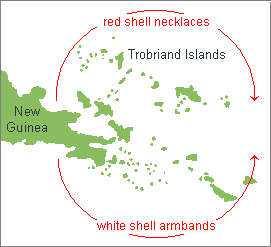 |
|
The way in which traders greeted each other on arriving at an island and carried out their trade was prescribed by tradition. While the senior trading partners formally greeted each other and reinforced their friendship and authority by giving kula gifts, the younger men usually unloaded more practical trade items on the beach to be bartered. These were mostly surplus luxury items from their home islands. The kula gifts were exchanged with the assumption of generalized reciprocity. The regular trade goods were mostly traded in a manner that resulted in balanced reciprocity. If asked why they were undertaking these long distance trading expeditions, the Trobriand Islanders would very likely emphasize the social rather than the economic gain. However, both were the result.
